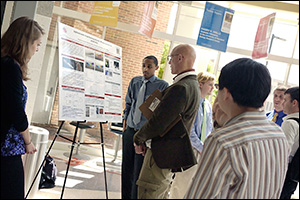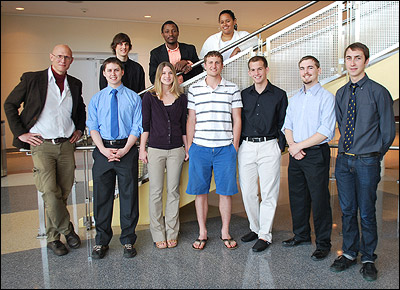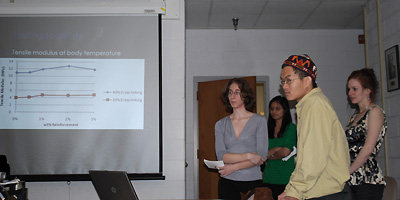News Story
MSE Capstone 2010

The MSE Class of 2010. Back row, left to right: Marshall Schroeder, Stephan Kitt, Alex Kao, and Paul Lambert. Middle row, left to right: Karam Hijji, Ashley Lidie, Abigail Boyle, and Mike Grapes. Front row, left to right: Christine Lau and Steven Crist.
The team of ten students—Abigail Boyle, Steven Crist, Mike Grapes, Karam Hijji, Alex Kao, Stephan Kitt, Paul Lambert, Christine Lau, Ashley Lidie and Marshall Schroeder—created a dynamic microelectromechanical systems (MEMS) microphone for their final project.
Tiny MEMS-based microphones are commonly used in devices such as cell phones, video recorders, laptops, and hearing aids. MEMS devices provide better quality audio capture than the more common, macro scale electret condenser microphones (ECMs), covering the entire range of human hearing (30Hz-30KHz) while consuming less power.
Most of the research and development of MEMS microphones to date has been on those of the condenser variety, which require a power source in order to function. Dynamic microphones, however, do not, because they use a permanent magnet and a mobile induction coil to capture sounds. If incorporated into MEMS devices, dynamic microphones would eliminate the need for an outside power source, making them smaller and more efficient. The availability of these systems could potentially open the door to new applications, including threat location detection and energy harvesting from noise. The Capstone team was inspired by the mass-market potential of a dynamic MEMS microphone, which has not yet been developed.
Over the course of their presentation, the seniors described how they used analytical modeling to design a cantilever-based actuator with very flat frequency response across the audible frequency range. They also described the multi-step process that they developed in attempting to make a usable prototype device, and some of the pitfalls that they came across in attempting the fabrication in the Clark School's FabLab, a world-class cleanroom facility.
"They were able to work through a design with many interconnected tasks, including optimization of the magnet array shape parameters and of the mechanical actuator," says Professor Ray Phaneuf, who advised the Capstone project. "This was an impressive effort by a strong, multifaceted team."
What Goes Into a Final Project?
The Capstone class of Spring 2010 made this video to document the stages of development of their project:
For More Information:
Watch a video the Class of 2010 made about their Capstone experience »
Published May 21, 2010













